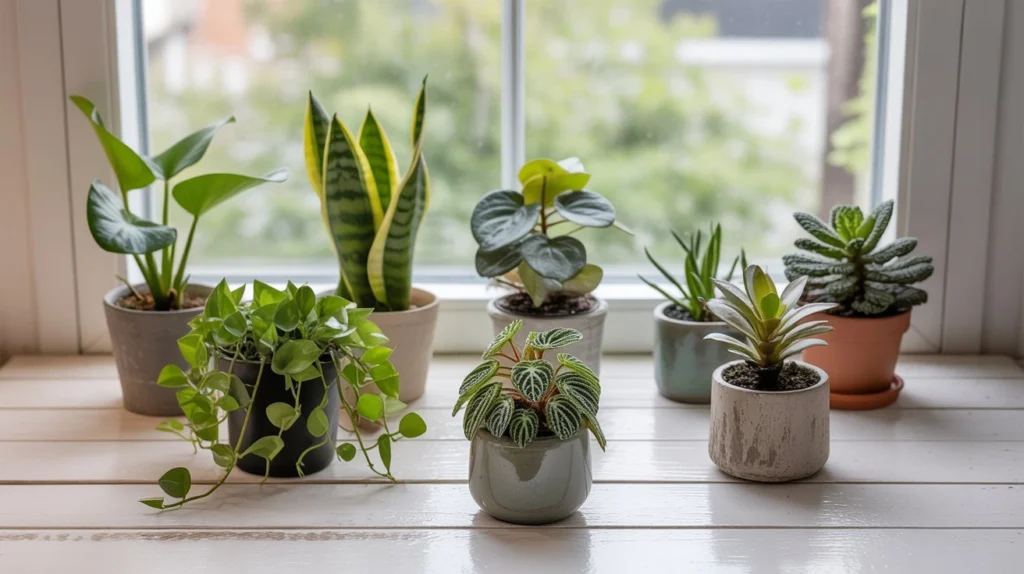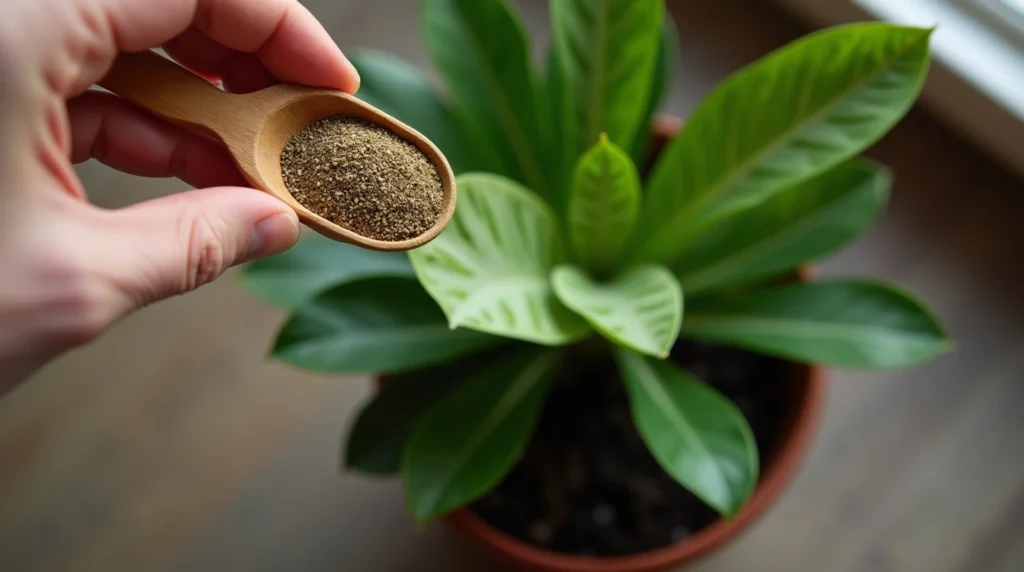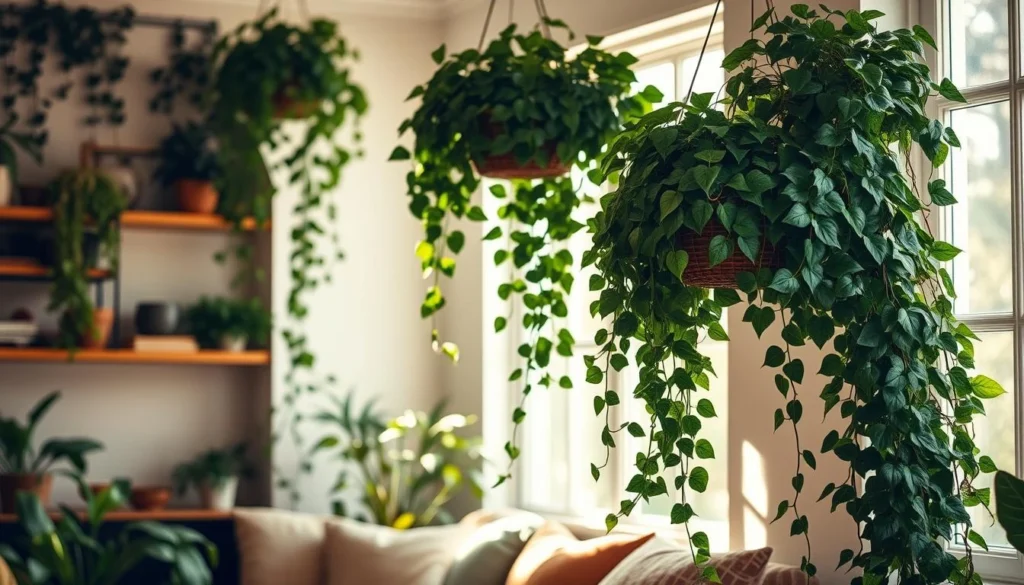
Did you know that greenery indoors can make you happier and more productive? Ivy plants are a favorite for home decor. They’re easy to care for and fit well in any space.
Adding these plants to your home can make it look amazing. With the right care, they’ll flourish and become a beautiful part of your indoor plant decor. We’ll show you how to keep them healthy and vibrant.
Table of Contents
All About Indoor Ivy Plants
Indoor ivy plants are both beautiful and useful, making them a wonderful choice for any room. They can grow well in many environments. This makes them perfect for people with all levels of gardening skills.
What Makes Ivy Perfect for Indoor Growing
Ivy plants are ideal for indoor growing because they can handle different light levels. They also need very little care. This means they can fit into various rooms in your home, no matter the light.
The History and Characteristics of Ivy
Ivy has a long history, with English ivy (Hedera helix) being a favorite for its heart-shaped leaves. Ivy plants love to climb or trail. They can be trained to grow up walls or trellises, or they can cascade down from hanging baskets.
| Ivy Variety | Lighting Needs | Maintenance Level |
|---|---|---|
| English Ivy | Low to Bright Indirect | Low |
| Devil’s Ivy | Low to Bright Indirect | Low |
| Swedish Ivy | Bright Indirect | Moderate |
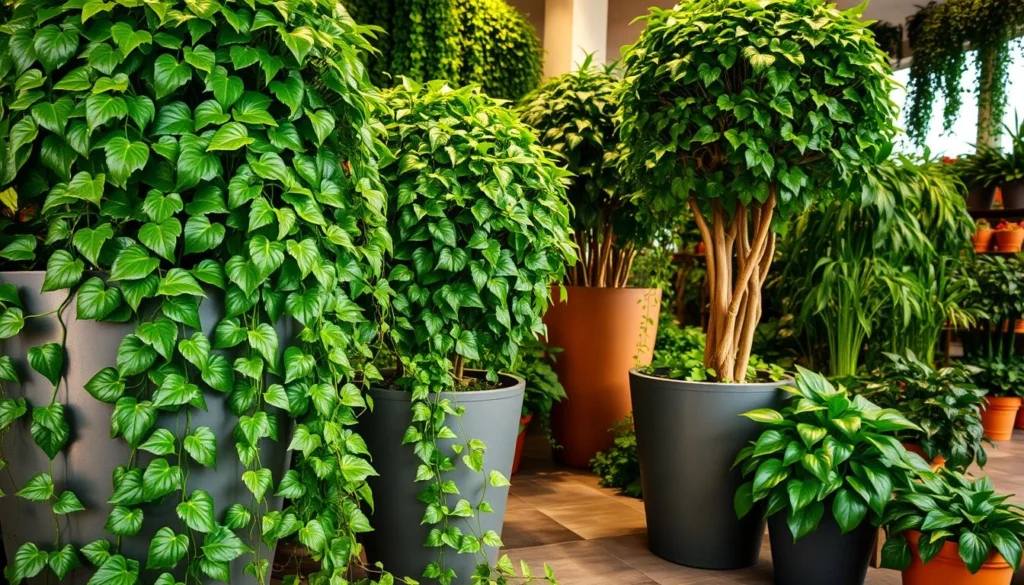
Popular Ivy Varieties for Indoor Environments
Ivy plants can brighten up any indoor space, even in low light. There are many varieties to choose from. Here are some of the most popular ones for indoor use.
English Ivy (Hedera helix) Varieties
English ivy is very common and versatile. It can grow well in different lighting conditions. It comes in many cultivars, each with its own texture and color.
Variegated English Ivy Options
Variegated English ivy has leaves with white or yellow markings. It adds a decorative touch to any room. These varieties are great for adding visual interest indoors.
Compact English Ivy Cultivars
Compact English ivy is perfect for small spaces or containers. It’s easy to care for and can be trained to climb or trail. This makes it a versatile choice for indoor gardening.
Devil’s Ivy (Pothos) Options
Devil’s ivy, or Pothos, is a favorite for indoor gardening. It’s low-maintenance and can grow in low light. It’s ideal for beginners.
Swedish Ivy and Algerian Ivy Varieties
Swedish ivy and Algerian ivy are also popular for indoor gardens. Swedish ivy grows fast and has heart-shaped leaves. Algerian ivy has large, lobed leaves.
Top Indoor Ivy Plants for Low Light Conditions
For areas with little natural light, some ivy varieties do well. Pothos and English ivy are top picks for low-light areas. They’re perfect for rooms with limited sunlight.
- Pothos: Known for its ability to grow in low light and requires minimal maintenance.
- English Ivy: Versatile and can grow in a range of lighting conditions, including low light.
- Swedish Ivy: Prefers bright, indirect light but can tolerate low light conditions.

Benefits of Growing Ivy Plants Indoors
Indoor ivy plants do more than just look good. They improve the air quality and make your space look better. They are great for any home or office.
Air Purification Properties
Ivy plants clean the air by removing bad stuff. This makes the air healthier to breathe. It also helps prevent breathing problems.
Aesthetic and Decorative Value
Ivy plants bring natural beauty inside. They can climb or trail, making them perfect for decorating. They add a unique touch to any room.
Health and Wellbeing Benefits
Ivy plants do more than clean the air. They also help your mental health. Studies show they can lower stress and make you feel happier.
| Benefits | Description |
|---|---|
| Air Purification | Removes toxins and pollutants from the air |
| Aesthetic Appeal | Adds natural beauty and versatility to indoor decor |
| Mental Wellbeing | Reduces stress and improves mood |
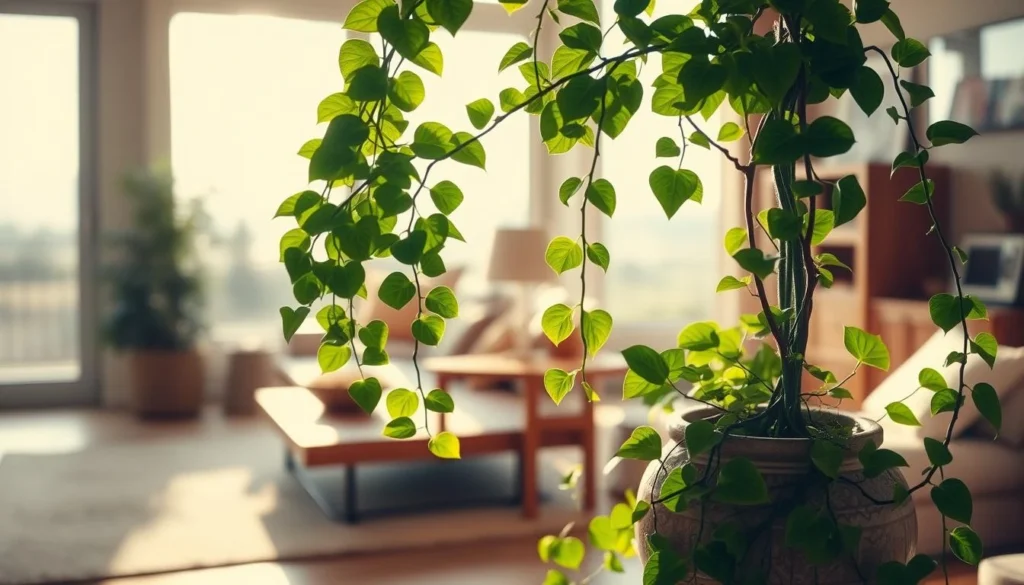
Essential Care Requirements for Indoor Ivy Plants
To keep your indoor ivy thriving, it’s key to know its care needs. These plants are flexible and can grow in many conditions. But, the right environment keeps them healthy and lively.
Light Requirements and Placement
Indoor ivy can handle different light levels, from dim to bright. But, direct sunlight can burn the leaves. An east- or west-facing window is perfect. Grow lights can help during winter when days are short.
Watering Schedule and Humidity Needs
Water your ivy when the top inch of soil is dry. Don’t overwater to avoid root rot. Ivy likes a humid spot, 40-60% relative humidity. You can use a water tray or a humidifier to boost humidity.
Soil Type and Fertilization
Choose a potting mix that drains well to avoid soggy soil. A mix for tropical or houseplants works well. Feed your ivy with a balanced fertilizer in spring and summer. Use half the recommended strength to protect the roots.
Temperature Considerations
Indoor ivy likes temperatures between 65°F to 75°F (18°C to 24°C). Keep it away from heating vents, fireplaces, and drafty windows. Sudden temperature changes can stress the plant.
By following these care tips, you can enjoy a thriving and beautiful indoor ivy. It will make your home look great and improve the air quality.
Propagation and Growth of Indoor Ivy Plants
To keep your indoor ivy thriving, it’s key to know how to propagate it. Propagating indoor ivy plants is easy and great for sharing or growing your garden.
Stem Cutting Propagation Methods
Stem cuttings are a common way to propagate indoor ivy. Take a section of stem with 4-6 leaves and remove the lower leaves. Put the cutting in water or moist soil. Keep it moist and warm until roots grow.
Water Propagation Techniques
Water propagation works well for indoor ivy too. Just put a stem cutting in water, making sure the node is under water. Roots will grow in a few weeks. Then, move the cutting to soil in a pot.
Encouraging Bushy Growth
To make your indoor ivy bushy, pinch off the tips of long vines. This makes the plant grow more laterally, making it fuller. Regular pruning also keeps the plant healthy and in shape.
Maintenance Tips for Healthy Indoor Ivy
With the right care, your indoor ivy can thrive. Regular pruning and repotting are key. Understanding these tasks is essential for a lush, healthy plant.
Pruning and Training Techniques
Pruning is vital for indoor ivy care. It controls size, encourages growth, and keeps the plant looking good. Regular pruning means cutting back vines and removing dead leaves.
Controlling Ivy’s Climbing Habit
To manage ivy’s climbing, use a trellis or stake. This keeps the plant neat and adds beauty. Training your ivy to climb also saves space.
Shaping and Directing Growth
Shaping your ivy involves regular pruning. You can also use wires or clips to guide stems. This helps keep the plant in shape.
Repotting Guidelines
Repotting is needed when your ivy outgrows its pot. Choose a slightly larger pot and a well-draining mix. Repotting is best in spring when the plant is growing.
Seasonal Care Adjustments
Seasonal care adjustments are important. For example, water less in winter. Monitoring your plant’s needs and adjusting care is key.
By following these tips, your indoor ivy will flourish. It will bring beauty and freshness to your home.
Troubleshooting Common Indoor Ivy Problems
Indoor ivy is easy to care for, but you might face some common issues. Knowing how to spot and fix these problems is key to keeping your ivy healthy.
Identifying and Treating Pest Infestations
Pests like spider mites and scale insects can trouble indoor ivy. Always check your plants for signs of these pests.
Spider Mites and Scale Insects
Spider mites make leaves turn yellow or bronze. Scale insects look like small, stuck bumps on stems and leaves. Use insecticidal soap or neem oil to fight these pests.
Preventative Measures
To stop pests, keep your plants well-ventilated and don’t overwater. Clean leaves with a damp cloth often to help.
Addressing Leaf Issues: Yellowing, Browning, and Dropping
Leaf problems can stem from too much or too little water, or from extreme temperatures. Adjust your care to fix these issues.
Reviving a Struggling Ivy Plant
If your ivy is struggling, check its environment and care. Look for pests, adjust watering and feeding, and trim off dead leaves.
| Issue | Cause | Solution |
|---|---|---|
| Yellowing Leaves | Overwatering or Pests | Adjust Watering, Inspect for Pests |
| Browning Leaves | Underwatering or Extreme Temps | Adjust Watering, Check Temperature |
| Dropping Leaves | Overwatering or Root Bound | Adjust Watering, Consider Repotting |
Read More :
How to Use Peat Moss for Indoor Plants and Container Gardening
Conclusion: Enjoying Your Thriving Indoor Ivy
With the right care, your indoor ivy plants can flourish. They become a stunning part of your indoor decor. This article has given you the tips to make your indoor ivy plants thrive. They offer many benefits, like purifying the air and adding beauty.
Indoor ivy plants are easy to care for and bring many advantages to your space. Adding them to your decor makes your environment healthier and more beautiful.
Now, you know how to care for your indoor ivy plants. You can relax and enjoy their beauty and benefits in your home or office. With proper care, your plants will keep growing, making your space even more lovely for years.
FAQ
What are the best ivy varieties for indoor decor?
Popular ivy varieties for indoor decor include English ivy, Devil’s ivy, Swedish ivy, and Algerian ivy. They thrive in various lighting conditions. They add a touch of greenery to your space.
How do I care for my indoor ivy plants?
To keep your indoor ivy plants thriving, ensure they get the right light, water, and nutrients. Check the soil moisture and fertilize sparingly. Prune regularly to keep them healthy and in shape.
Can I grow ivy plants in low-light conditions?
Yes, many ivy varieties can grow in low-light conditions. They’re perfect for rooms with little natural light. But, some may need more light to stay vibrant and healthy.
How often should I water my indoor ivy plants?
The watering frequency depends on humidity, temperature, and soil type. Check the soil moisture by sticking your finger in. Water when it feels dry. Avoid overwatering to prevent root rot.
What are the benefits of having indoor ivy plants?
Indoor ivy plants purify the air, add beauty, and offer health benefits. They remove toxins, enhance your space, and can reduce stress and improve mood.
How do I propagate indoor ivy plants?
You can propagate indoor ivy plants using stem cuttings or water. Take healthy stem cuttings, remove lower leaves, and plant them in a pot or water. Keep the soil or water moist until roots grow.
Why are my ivy leaves turning yellow or brown?
Yellowing or browning leaves can be due to overwatering, underwatering, or extreme temperatures. Check your watering schedule and adjust your care routine. Ensure your ivy gets the right light and nutrients.
Can I use indoor ivy plants as a natural air purifier?
Yes, many ivy varieties are great for purifying the air. They remove toxins and pollutants, making your indoor air healthier.
How do I choose the right planter for my indoor ivy?
When picking a planter for your indoor ivy, consider size, material, and drainage. Choose a planter that’s well-draining, has enough room for roots, and fits your decor.
